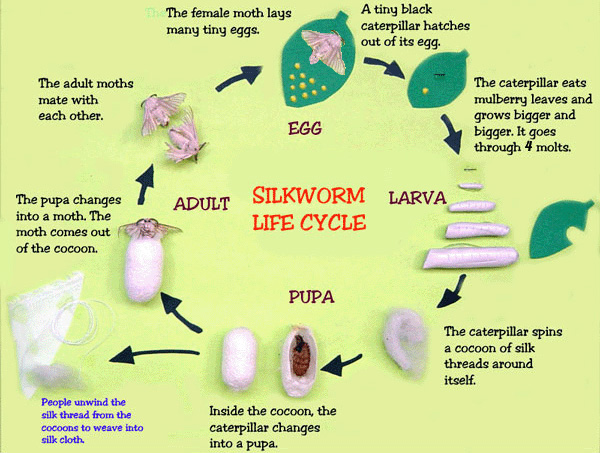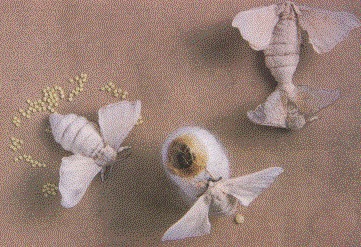First, I want to welcome fellow bloggers The Bayfield Bunch, Al and Kelly http://thebayfieldbunch.com
Because of Al's writing and photos, I feel like I know him. He writes a terrific blog. Be sure to stop by and read his posts. It's worth your time.
Second, I welcome Pam to blog land. She and her husband Donn are starting a new farm in southern Indiana. If she doesn't have a blog, she needs to write one about establishing a new farm, building fences, strange neighbors and her animals. Go for it , Pam.
Third, I'd like to welcome all readers. If you would like, click on the follow button and become a regular follower. I have a way to go to catch up with The Bayfield Bunch! He has been blogging, I believe, since 2007. .
Now, to the Silkworms!


I have been keeping the cocoons in egg cartons. One cocoon per egg space. I have no idea why I went over to look at the cocoons, but voila there was a hole in one cocoon! Oops! I was not expecting them to emerge so soon! Where is the moth? I found it on the underside of the egg carton and there was another cocoon from which the moth had emerged. Ah ha... a third has joined the other two. I found it on the lid of the second egg carton. They are a bit early! Maybe it is the hot days? Maybe my mental calendar? Who knows! (Only the Shadow Knows, hahaha)
The last of the stubborn silkworms spun their cocoon just last week. I guess we will have guests with us on our trip to Danville, Illinois next week. Thank goodness these critters do not have the ability to fly.
While inside the cocoon, the silkworm sheds its skin and becomes a pupa as shown below. Inside the brown pupa shell, it slowly changes into a moth. This process takes three weeks.( or a bit less time). Yep a bit less.


The moths usually emerge at dawn. The adult moth has a special spit which is used to dissolve the silk so it can push its way out of the cocoon. Silkworm farmers kill the moths before they emerge and make holes in the silk thread. When they emerge, the wings are crumpled, but they get pumped full of fluid and harden it about an hour.
Moths cannot fly, and neither eat nor drink. They mate, lay eggs, and then die within five days. After the moths emerge from the cocoon, they look for an opposite-sex moth to mate with. Females are significantly larger than males. Females periodically extrude a scent gland through the hole in their abdomen. Males have a flap of skin at the end of their abdomen and flutter their wings a lot. Each moth will "urinate" a reddish-brown fluid shortly after emerging from the cocoon. It dries to look like blood.

The moths stay mated for about a day. At the top of the picture, notice how much larger the female is. So far, we have two female silkworms and one male, I think. The third moth's wings are not fully extended, but the body looks smaller.
After separation, the female lays eggs and the male looks for another female. Sometimes another male grabs the female before she can lay eggs. Each female will lay between 200 - 500 golden yellow eggs!
When first laid, all eggs are lemon-yellow. After three days, they will turn white if they are infertile, or turn black if they are fertile. Fertile eggs might hatch in about two weeks after being laid in the middle of the summer, but they usually won't hatch unless subjected to "winter" in your refrigerator for at least several weeks. Wait until the eggs turn black before putting them in the Zip Lock bag in the refrigerator. Once you take eggs out of the fridge, they will hatch in 7-20 days, or maybe not at all. Direct sunlight in the morning for a few hours hastens hatching. Eggs will remain viable in the refrigerator for about five years, but I don't think they will be in our refrigerator. I'm not up to that yet, Zip Lock or not.
It is interesting to note that 40,000 silkworm eggs (once ounce or 28 grams) will hatch into worms which will eat 6,500 kilograms (3,500 pounds) of mulberry leaves, and will spin cocoons which will produce 8 kilograms (18 pounds) of silk thread. It takes 1700 to 2000 cocoons to make one silk dress!
I plan to use the silk from the cocoons to spin and to use in my wet felting. It will be harder to spin since I decided to let them complete the full cycle. The moths will create an opening or "doorway" in the cocoon and exit. Most people that want to spin the silk will boil the cocoons, killing the larva, so there is no opening and the silk threads are in one continuous thread.
Since this is my first experience, I have chosen to enjoy the full cycle then use the cocoons however it is possible.
No comments:
Post a Comment
Thank you for leaving your comment. We do enjoy hearing from you.